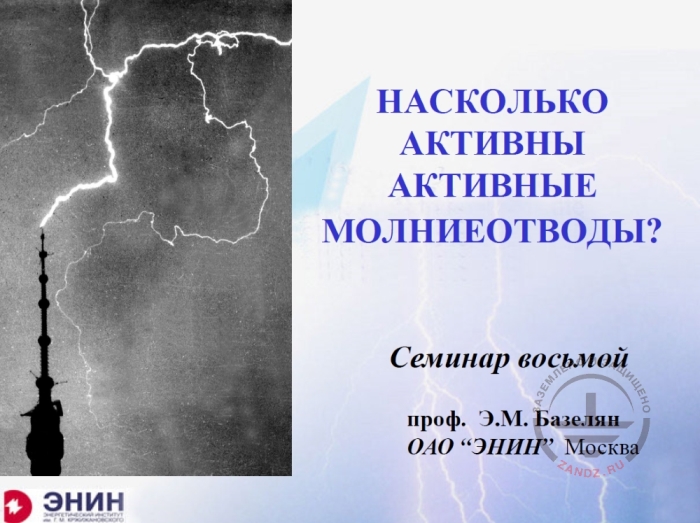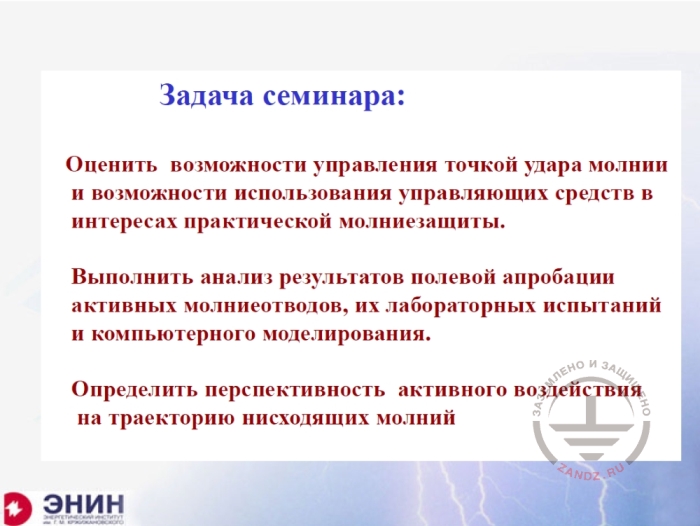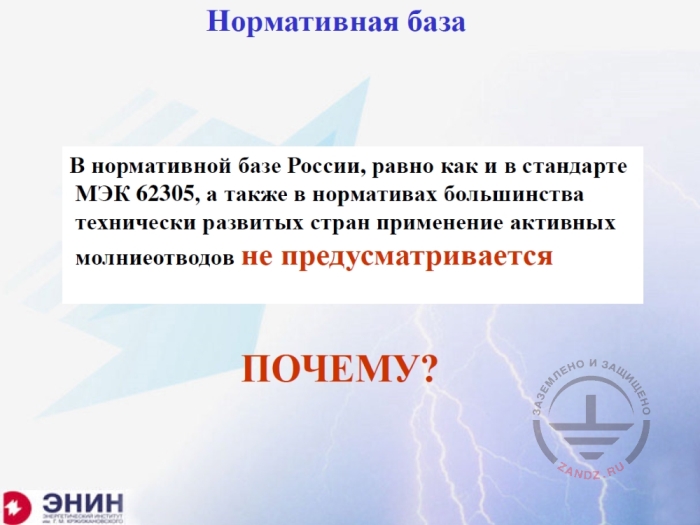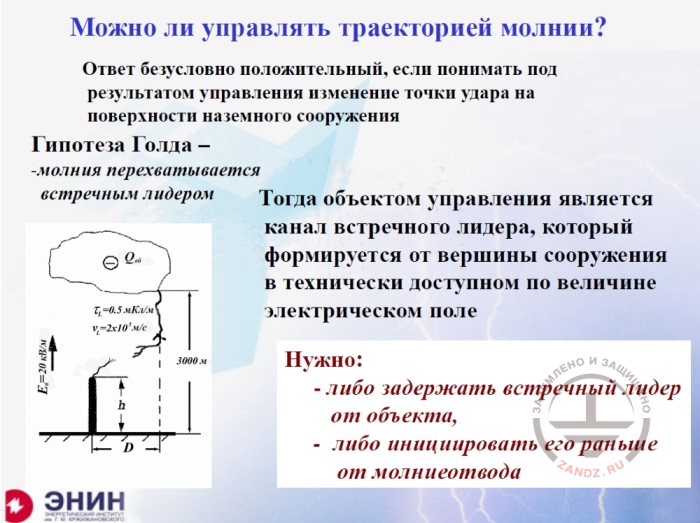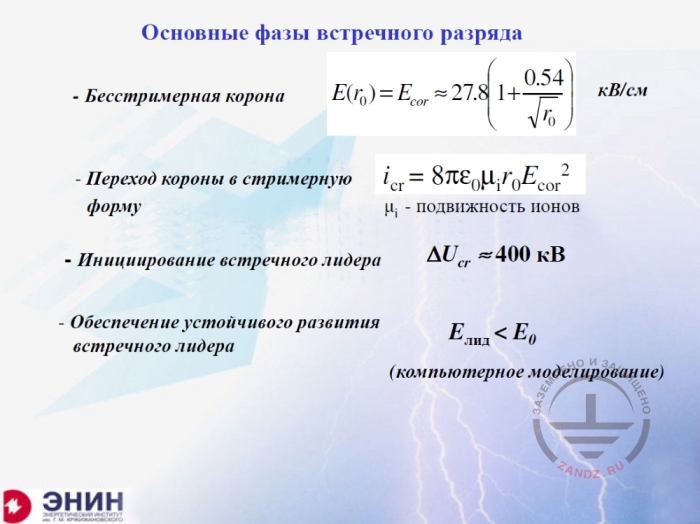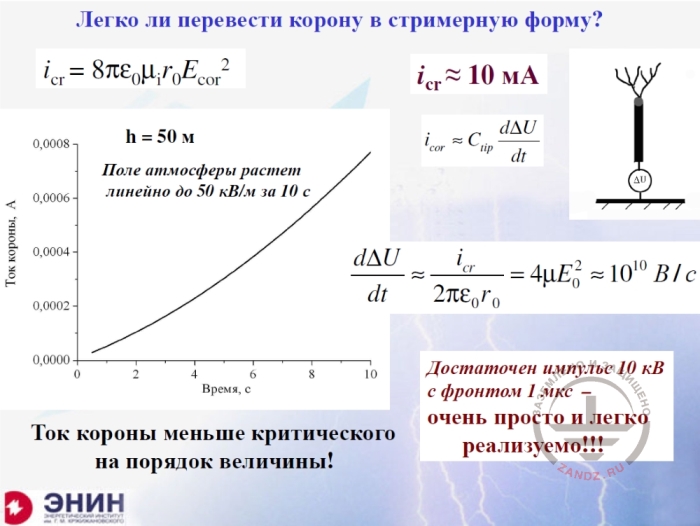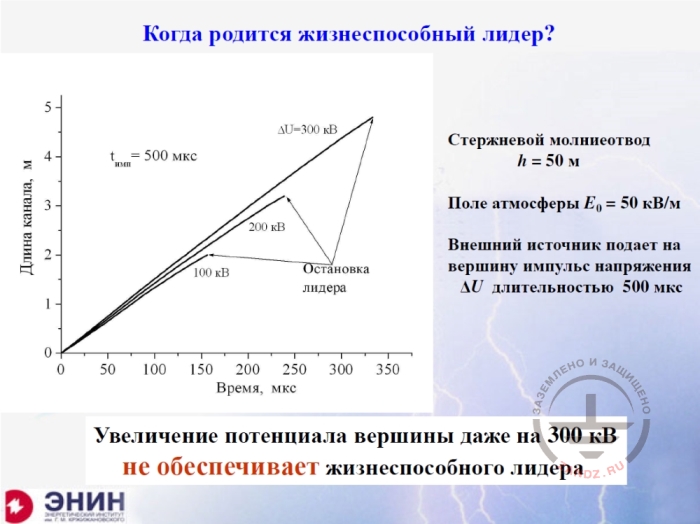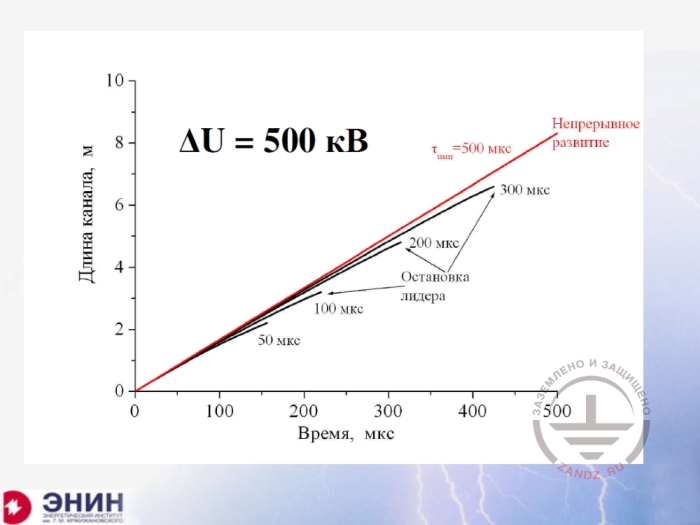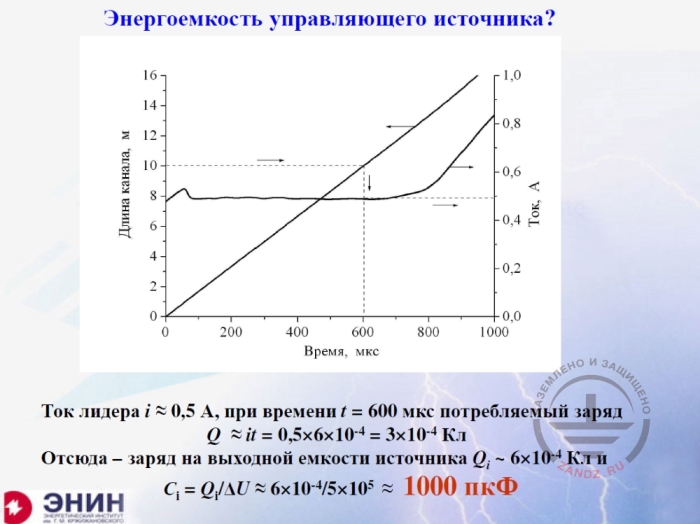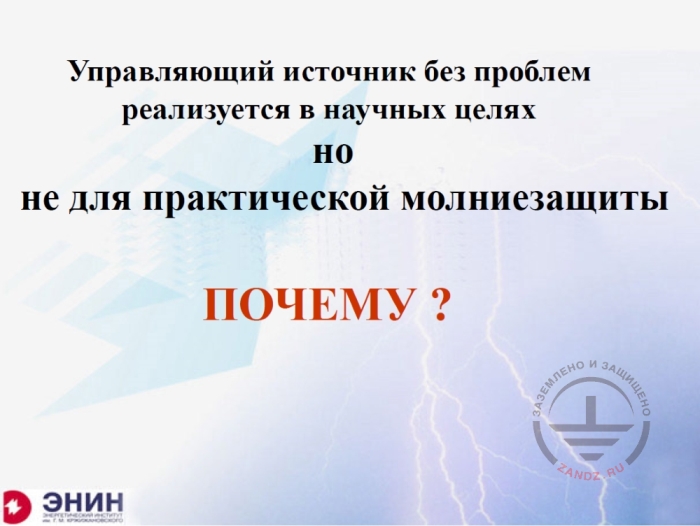The eighth webinar of a series "Grounding and lightning protection: issues and problems arising in the design"
(was held on March 18, 2015 at 11:00 Moscow time)
How active are ESE lightning rods?
Is it possible to control the point of the lightning strike? Any expert will answer "yes" to this question without hesitation. But he will start hesitating, if you add a phrase ''...for the purpose of practical lightning protection. " As now he will need to consider the cost of implementing managing activities, their reliability, running costs and compatibility with the technological functions of the protected facility.
Full-screen mode with the quality of "720p" is recommended.
The physical mechanism of actions intended to control a lightning strike is clear. The point of a lightning strike is determined by the counter leader channel that starts from a facility on the ground surface. In order to ensure the effective protection against direct lightning strikes, it is necessary to initiate a counter-leader from the lightning rod as soon as possible or to delay its formation from the protected facility. The required levels of control actions are also known. Unfortunately, they are feasible for research purposes only, but not very suitable for practical lightning protection. That's why lightning protection regulations do not pay due attention to the ESE lightning protection neither in Russia,nor in the vast majority of technologically developed countries.
However, ESE lightning rods are advertised very aggressively. Even regulatory bodies in Russia are actively involved in the advertising process. Such a commercial activity becomes socially dangerous and needs to be restrained.
During the webinar, we will give a detailed analysis of lightning strike control actions, and show actual data about their capabilities gathered during field observations, laboratory studies and theoretical review.
We will also discuss the implications of the possible use of ESE lightning rods including the most popular type - ESE lightning rods, at the existing industrial facilities.
Finally, we will consider the opportunities of harmonizing ESE lightning rod concept with the Russian lightning protection regulatory framework and assess the prospects of the future developments.
Webinar text. Page 1
Quick navigation through slides:
Page 1:
1. How effective and feasible are ESE lightning rods
2. Seminar task
3. Regulatory framework
4. Is it possible to control lightning trajectory?
5. Basic phases of a counter discharge
6. Is it easy to shift corona into a streamer form?
7. When will sustainable leader appear?
8. Pulse duration
9. Energy intensity of the managing source
10. Implementation of the managing source
11. High cost of high-voltage source
12. In a manifold example, corona produces one order less
13. Increase of the number of corona centers doesn’t give any effect
14. Synchronizing block is not obligatory in ESE lightning rods
15. It is impossible to carry out synchronization on the charge growth on a cumulative
16. Problem of multi-component lightning
17. What do producing companies offer
18. How ESE lighting rods are tested
19. Device efficiency index
20. Experiment in ENIN in 1975
21. Experiments in “26 Central Research Institute” in 2014
22. Field observations
Estimated reading time: 50 minutes
How effective and feasible are ESE lightning rods
— Good afternoon, dear colleagues! I am sitting in front of a web camera and talking to you for the eighth time already. This time, however, we intend to talk about ESE lightning rods. And as usually, in this case, my dear assistance Nadezhda will help me to communicate with you.
— Good afternoon, dear colleagues! ZANDZ project with its next webinar is greeting you. Please write in the chat how well you can hear and see us and I am giving the floor to our dear Eduard Meerovich.
— You know, the preparation to this seminar was very hard, I even asked the organizers for a double term, because I had so many doubts. The doubts of two kinds. The first one - if I have the right to hold such a seminar. The matter is as follows. I was not very much concerned about the professional preparation, because I've been sitting in an experimental laboratory for 25 years and working on a long and rapid lightning. Almost for the same time period, I've been working with the theoretical research of lighting, practical lightning protection and that's why I am well familiar with the material. But one circumstance left me perplexed. I've always considered and remain to consider myself an active opponent of ESE lightning rods. And I had a doubt if I have a right to tell you what I think, because my personal opinion is to some extent biased. However, I decided to hold this seminar for you to hear the argumentation which the opponents of ESE lightning rods have. And I also decided to make it, because the organizers of the seminar, as I know, made an agreement with one of companies producing and selling ESE lightning rods and they are ready to give their ideas too. So there should a very interesting discussion I guess. I have a request to you. Please, give me the chance to answer all questions in the end, so I don't interrupt a report which is very difficult for me. But if the question is very critical, Nadezhda will catch it and interrupt me. So, I begin.
Seminar task
Estimate the possibilities of managing lightning strike point and possibility of using managing means in the interests of practical lightning protection.
Perform analysis of results of field probation of active lightning rods, their laboratory tests and computer modelling.
Define the prospect of active impact on the trajectory of downward lightning.
What do I want to study? I want to study the following things. Is it possible to manage lightning? If yes, how? And if it is known how, then does it fit or doesn't in order to control lightning for the sake of lightning protection? This is the main question to be answered. Because if any specialist gets a question - is it possible to control lightning? He would probably say: “Yes, of course”. And no doubts in that regard.
Regulatory framework
The use of ESE lightning rods is not envisaged in the Russian regulatory framework, like in IEC 62305 standard and also in the regulatory bases of the majority of technically developed countries.
Why?
The question is different. Is it possible to manage lightning for the sake of mass lightning protection?
Is it possible to control the trajectory of lightning?
The answer is of course positive, if to understand the change of strike point on the surface of the on-ground structure under the result of the management.
Gold’s hypothesis – lightning is captured by the counter leader.
Then the channel of the counter leader which forms from the top of the structure in a technically available electric field becomes a management object.
It is necessary:
- Either to impede the counter leader from the object
- Initiate it earlier from the lightning rod
It is not hard to manage lightning. It's not hard because from the moment of birth of our Universe, no lightning strike ever hit no object located on the ground surface. The situation was always as follows. A well conductive ionized channel, which lighting protection specialists call a counter leader, is developing towards lightning from some towering construction. This counter leader can develop to some decent length. Say, from a lightning rod which is 30 meters high, it can develop to the same length, practically increasing the height of lightning rods. The meeting of a lightning channel and a counter leader is a lightning strike into the object. So the problem of managing a lightning strike comes down to the problem of managing a counter leader. And the specialists see no problems here, for this reason. Counter leader channel is quickly developing in ordinary electric fields, which are easily achieved in laboratory conditions. There are voltage sources, which are ready to make such fields at the laboratory. Laboratory voltage sources are able to create counter leader channels a hundred of meters long. And all these things can be used to control lightning strike point. So, it means, the problem is not here.
The main phases of a counter discharge
Бесстримерная корона – streamerless corona
Переход короны в стримерную форму – transition of corona into a streamer form
Инициирование встречного лидера – initiation of the counter leader
Обеспечение устойчивого развития встречного лидера – provision of a stable development of a counter leader
The problem is to make a device applicable for practical lightning protection. And what to start with in this device? We need to start with money, because today the cost of external lightning protection is the share % of the protected object cost. And nobody wants to pay more. And the first question if we can make a cheap managing device? This is a very serious question. The second question which we have to discuss is as follows. If we make such devices, will they have the same reliability which is required for a modern lightning protection? Modern lightning protection is operated by the reliability at the level of 0,999. So will our managing devices function with the reliability of 0,999? This is a new question. Next question. If we make these devices and are ready to deliver them. Will there be any operating costs? And do we have to think about operating costs of these managing devices? If their management is quite serious, then it is quite possible to hope for their mass application. And then the final thing which is not always discussed. We are talking about rapid response of devices. Because the device that controls lightning should be rapid. Is there a problem? The problem is easy. The thing is that today data about lighting discharges, which are present in the world are known and summarized by the IEC on large electric networks CIGRE.
This commission made a report, which was modestly called a brochure. The brochure contained summarized data on lightning. And if you read through it, you will see, that about 70% of all lightning strikes are multi-component. It means there can be several electric discharges in one lightning flash. Averagely 3-5, but the thing is that half of these discharges doesn't repeat the trajectory of the first one. The discharges go along other trajectories. They are different by the trajectories. And from the lightning protection view, each such component is a new lightning flash. They should be all intercepted. It means, the device must be ready for a repeated work of each next component, which go with a pitch of less than 1/10 seconds. All this together makes lightning protection specialists to think if it is possible to make ESE lightning protection? Let's see what is being sold at the lightning protection market. It is an important moment and I want to study it from the following positions. What gives a start to a counter discharge? A counter discharge starts with corona, which the Western people like to call glucorona. We call it avalanche corona, streamerless corona. It's not important how it is called; it is important what this device is. It's a weak glow at the top of a lightning rod or object, which doesn't grow and doesn't turn into a channel intercepting lightning. It doesn't happen for such a reason. For the channel to grow, it is necessary for this corona, which appears in an electric field, which is defined by the formula, it is somewhere at the level of 30 kV per cm. So this corona can heat the air in its volume, because only a hot channel which keeps high conductivity can grow. And for the channel to keep high conductivity, it is necessary for the electrons to exist. And electrons, formed in the result of ionization die in a normal, not heated air, in 1/10 seconds. It is necessary to heat ionization zone, and in order to heat it, it is necessary to switch from this streamerless corona to the next development shape - the so-called streamer discharge, which presents itself an unfolded brush of thin ionized channels. These are the thinnest channels, which cannot be heat up, because there is not enough energy, but they can't heat up their base - the so-called stem. And for this heat to happen, corona must be powerful enough. Streamer flash should use voltage at the level of about 500 000 V. Only after that a growing channel can develop in the channel. This is the complex sequence of events.
Is it easy to switch corona to a streamer form?
Ток короны, А – corona current, A
Поле атмосферы растет линейно до 50 кВ/м за 10 с – Atmosphere field grows linearly to 50 kV/m in 10 seconds
Время, с – time , s
Ток короны меньше критического на порядок величины- Corona current is less than critical to an order of magnitude
Достаточен импульс 10 кВ с фронтом 1 мкс – The pulse 10 kV with a front of 1 ms is enough
Очень просто и легко реализуемо – very simple and easily implemented
Now, when to switch to a streamer flash from an ordinary corona? It happens at a quite great corona current. And this corona current, it is well known, it is estimated and this is current at the level of about 10 mA. If you look how the top of a lightning rod coronates. Here you see how corona current grows from a lightning rod 50 m high - it's a high rod. In an electric field, it will be strong too - about 50 kV/m. The field is not always created by a thunder cloud. But still, the current which appears here, it is one order less the current required for a streamer switch. Question: is it possible to help this? And we see the following thing here. We can help easily. It is enough to give a lift to the lightning rod potential, for example to a relatively small value in order to make the current required for a stream switch flow. It turns out, that if you make a source, for only 10 kV for example, and will make the front of this source equal to 1 ms, you will make the current, which will give birth to a streamer flash. See, I am carrying water to those who produce ESE lightning rods. Because ESE lightning rods operate with the principle, that their internal source creates a relatively low voltage, lifts up the potential of lightning rod head and the streamer process, which will finally lead to the birth of a counter leader, will start from there.
When will a sustainable leader appear?
Длина канала, м - channel length, m
Стержневой молниеотвод – rod lightning rod
Остановка лидера – leader stop
Время, мкс – time, ms
Поле атмосферы – atmosphere field
Внешний источник подает на вершину импульс напряжения длительностью 500 мкс – Exterior source gets on the top of the voltage pulse with the duration 500 ms
Increase of the top potential even to 300 kV does not provide the sustainable leader
But let us not rush with the estimation of ESE lightning rods. We've been working a lot on what will happen if I start a counter leader. What will happen to it? Will it be able to develop towards lightning or will it cease its development in a short distance. A very serious simulation model was made for this purpose. Dozens, hundreds of different variants and typical examples of such calculations as I want to show you were calculated on this simulation model. I will again operate by a very high lightning rod, which is 50 meters high and I will again think that the electric field in the atmosphere is great, because the average value is twice larger the one I am working with. I will think that my leader has been started and that this counter leader is supported by the pulse voltage of a great duration of 500 ms. Now I will see that is connected to the control impact? Control impact of 100 kV, the leader grew up to 2 meters and stopped its development. Not a lot of sense from such a leader. Lightning won't even feel such an increase of lightning rod height. I increased it twice - 200 kV, now the leader grew to 3,5 meters and stopped its development again. I took 300 kV, the leader grew to 5 meters and again stopped its development. There is not enough energy.
Pulse duration
Длина канала, м – channel length, m
Непрерывное развитие – continuous development
Остановка лидера – leader stop
Время, мкс – time, ms
Now another very important moment. And what pulse duration is required for the leader, which I pushed, not to strop and ran towards lightning? I did the following thing in the calculations. In the same situation, I took the managing voltage of 500 kV and started to significantly change duration of the pulse, which creates 500 kV. I started with 50 ms- not small pulse duration; however, at such duration the counter leader channel went about 2 m and stopped. It can't go any further. I am making 100 ms - the channel growth to a couple of meters. And when I approached 500 ms, my channel went through the zone of corona's spatial charge, broke through to the outer space and started to move towards the lightning channel. It means the outcomes I am going to make are quite sad. The outcomes are as follows - it is possible to control lightning, but it's very hard to make it in a cheap way. Because it costs quite a lot of money to make a source for several hundreds of kV and duration of several hundreds of ms.
Energy consumption of the managing source
Длина канала, м – channel length, m
Время, мкс – time, ms
Ток. А – current, A
Ток лидера - leader current
При времени – at time equal to
Потребляемый заряд – consumed charge
Отсюда- заряд на выходной емкости источника – It means the charge at the output capacity of the source
Let's see what source it should be? What electro-technical characteristics should it possess? What feeds this source? It feeds the leader channel. What current flows inside the leader channel? At the initial development part, the current flows at the level of Ampere shares, roughly speaking 0,5 A. If such a channel will grow with the current of 0,5 A during 600 ms, it will use the charge, which is at the level of 0,3 mCl. That means, we need to have such a charge at the capacity, but I need to keep the pulse duration. I estimate the pulse duration at the level of 0,5. It means during this time, the reserve capacity, which feeds the channel, should have twice a larger charge. I took this twice larger charge. Now if I divide this charge to the voltage I am working with, and I am working with 500 kV, it will mean the source capacity will be 1000 pF. Now the specialists, and I am sure there are specialists at the seminar. The specialists know how the capacity of 1000 pF looks at the voltage of 500 kV. What are the sizes of this capacity? And now remember and compare these sizes with the sizes of the devices that are being sold. The capacity of 500 pF, of 1000 pF with the voltage of 500 kV won't fit into any ESE lightning rod under no circumstances.
Implementation of the managing source
The managing source is implemented in scientific aims without any problem but not for practical lightning protection. Why?
Moreover, it will be hard to charge this capacity, because nobody wants to make a charging device at an ESE lightning rod. Atmosphere electric field can be used for this purpose. To charge the atmosphere electric field to 500 kV is practically impossible, because you won't get such a voltage.
Next Page >>
slides from 11 to 22+ questions and answers session
Useful materials for designers:
- Webinars with the leading industry experts
- Everything for the calculation of grounding and lightning protection
- Useful materials: articles, recommendations, examples
Related Articles:
 Lightning protection of residential and public buildings - answers to frequently asked questions in the design
Lightning protection of residential and public buildings - answers to frequently asked questions in the design
 Lightning Protection of Large Territories: Parks, Grounds, Plant Territories. Page 1
Lightning Protection of Large Territories: Parks, Grounds, Plant Territories. Page 1
 Lightning Protection of Large Territories: Parks, Grounds, Plant Territories. Page 2
Lightning Protection of Large Territories: Parks, Grounds, Plant Territories. Page 2
 Lightning Protection of Large Territories: Parks, Grounds, Plant Territories. Page 3
Lightning Protection of Large Territories: Parks, Grounds, Plant Territories. Page 3


